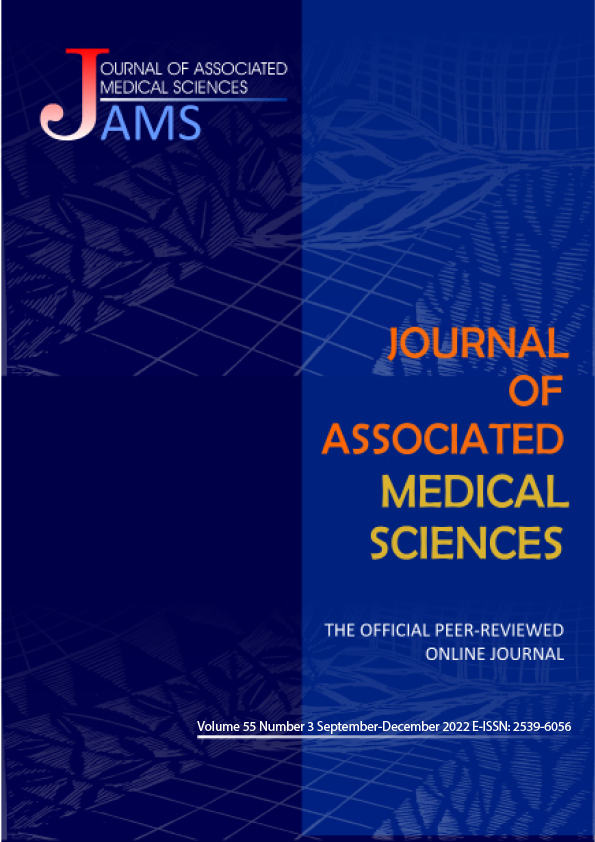Identification and monitoring of Mycobacterium tuberculosis growth in liquid culture by Antigen 85 detection
Main Article Content
Abstract
Background: Mycobacterium tuberculosis is the most common causative agent of tuberculosis. It releases secretory proteins, especially the Ag85 complex, from actively growing mycobacteria, which can be detected in mycobacterial liquid culture. Ag85B is the most abundant in the Ag85 complex and is an interesting target for the detection of tuberculosis. In addition, measuring Ag85 level is beneficial for comparing growing and non-growing mycobacteria in liquid culture.
Objectives: To detect Ag85B protein from active growing M. tuberculosis in liquid culture for the diagnosis of tuberculosis and compare the level of Ag85B between growing and non-growing mycobacteria.
Materials and methods: A sandwich ELISA assay using anti-Ag85B monoclonal antibody was performed to detect Ag85B protein. Drug-susceptible mycobacteria, M. tuberculosis H37Ra and M. tuberculosis H37Rv, as well as 12 other M. tuberculosis complex strains isolated from clinical specimens were cultured in liquid media. In addition, mycobacterial culture was separated into two conditions: untreated and treated with streptomycin. Then the liquid media were collected, filtered for sterility, and used for the detection of Ag85B. The levels of Ag85B between treated and untreated conditions were analyzed.
Results: In untreated mycobacterial culture, Ag85B protein was detected and continuously increased each day. However, Ag85B in treated mycobacterial culture increased slightly in the early days and then stabilized. These results demonstrate that the growth of mycobacteria was inhibited after culturing with streptomycin. Thus, the increase of Ag85B was not observed because this protein cannot be secreted by dead mycobacteria. On the other hand, living mycobacteria can secrete the Ag85B protein continuously. Moreover, Ag85B accumulated and increased with each passing day.
Conclusion: M. tuberculosis can produce and release Ag85B protein. In this study, detection of Ag85B in liquid culture by a sandwich ELISA assay was used to identify M. tuberculosis. When M. tuberculosis was suppressed or killed by anti-TB medications, it stopped growing and the increase in Ag85B proteins disappeared. As a result, the levels of Ag85B could be used to detect living mycobacteria. Furthermore, this knowledge can be further applied to monitor mycobacterial growth affected by testing mycobacteria with anti-TB drugs.
Article Details

This work is licensed under a Creative Commons Attribution-NonCommercial-NoDerivatives 4.0 International License.
Personal views expressed by the contributors in their articles are not necessarily those of the Journal of Associated Medical Sciences, Faculty of Associated Medical Sciences, Chiang Mai University.
References
Furin J, Cox H, Pai M. tuberculosis. The Lancet 2019; 393(10181): 1642-56.
World Health Organization. Global tuberculosis report 2020: executive summary. World Health Organization [Internet]. 2020 [cited 2020 Jun 15] Available from: https://apps.who.int/iris/handle/10665/337538/.
World Health Organization. (2020). Global tuberculosis report 2020. World Health Organization [Internet]. 2020 [cited 2020 Jun 15] Available from: https://apps.who.int/iris/handle/10665/337539/.
Adigun R, Singh R. Tuberculosis. In: StatPearls [Internet]. 2021 [cited 2021 Jan] Available from: https://www.ncbi.nlm.nih.gov/books/NBK441916/.
Ahmad S, Mokaddas E, Al-Mutairi N, Eldeen HS, Mohammadi S. Discordance across phenotypic and molecular methods for drug susceptibility testing of drug-resistant Mycobacterium tuberculosis isolates in a low TB Incidence Country. PLoS One 2016; 11(4): e0153563.
Karbalaei Zadeh Babaki M, Soleimanpour S, Rezaee SA. Antigen 85 complex as a powerful Mycobacterium tuberculosis immunogene: biology, immune-pathogenicity, applications in diagnosis, and vaccine design. Microb Pathog 2017; 112: 20-9.
Phunpae P, Chanwong S, Tayapiwatana C, Apiratmateekul N, Makeudom A, Kasinrerk W. Rapid diagnosis of tuberculosis by identification of Antigen 85 in mycobacterial culture system. Diagn Microbiol Infect Dis 2014; 78(3): 242-8.
Zhang W, Shu Q, Zhao Z, Fan J, Lyon C J, Zelazny A M, et al. Antigen 85B peptidomic analysis allows species-specific mycobacterial identification. Clinical Proteomics, 2018; 15(1). doi:10.1186/s12014-017-9177-6.
Joel D Er, Amber C, Miriam B. Dynamics of Mycobacterium tuberculosis Ag85B revealed by a sensitive enzyme-linked immunosorbent assay. the mBio. 2019 Apr 23; 10(2): e00611-19. DOI: 10.1128/mBio.00611-19.
Imaz M, et al. Performance of LED fluorescence microscopy for the detection of acid-fast bacilli from respiratory samples in peripheral laboratories in Argentina. Biomedica 2017; 37(2): 164-174.
World Health Organization. Global tuberculosis report 2019. World Health Organization [Internet]. 2019 [cited 2020 Jun 15] Available from: https://apps.who.int/iris/handle/10665/329368/.
Ryu YJ. Diagnosis of pulmonary tuberculosis: recent advances and diagnostic algorithms. Tuberc Respir Dis (Seoul) 2015; 78(2): 64-71.
Heemskerk D CM, Marais B, et al. Tuberculosis in adults and children [Internet]. 2015 [cited 2020 May 7] Available from: https://www.ncbi.nlm.nih.gov/books/NBK344406/.
Amicosante M, D'Ambrosio L, Munoz M, Mello FCQ, Tebruegge M, Chegou NN, et al. Current use and acceptability of novel diagnostic tests for active tuberculosis: a worldwide survey. J Bras Pneumol 2017; 43(5): 380-92.
Kuo CJ, Bell H, Hsieh CL, Ptak CP, Chang YF. Novel mycobacteria antigen 85 complex binding motif on fibronectin. J Biol Chem 2012; 287(3): 1892-902.
Lee BY, Horwitz MA. Identification of macrophage and stress-induced proteins of Mycobacterium tuberculosis. J Clin Invest 1995; 96(1): 245-9.
Goletti D, Lee MR, Wang JY, Walter N, Ottenhoff THM. Update on tuberculosis biomarkers: From correlates of risk, to correlates of active disease and of cure from disease. Respirology 2018; 23(5): 455-66.
Chakraborty S, Rhee KY. Tuberculosis drug development: history and evolution of the mechanism-based paradigm. Cold Spring Harb Perspect Med 2015; 5(8): a021147.


